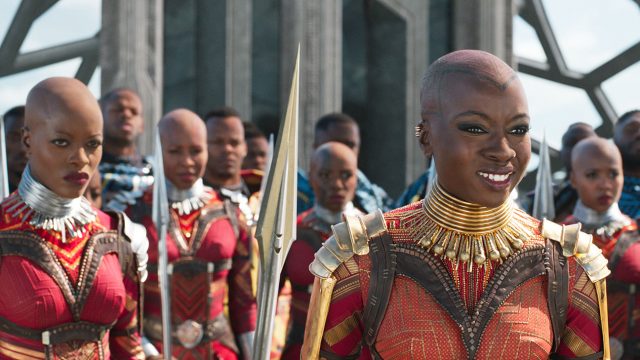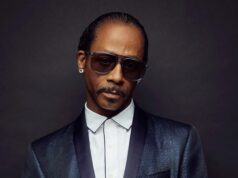
(First published FEBRUARY 16, 2018)
by N.D.B. Connolly
How ‘Black Panther’ Taps Into 500 Years of History
Johns Hopkins historian Nathan Connolly explains how Ryan Coogler’s film draws on centuries of black dreams of independence to create Wakanda.
Matt Kennedy/Marvel Studios
Nathan Connolly
Johns Hopkins historian Nathan Connolly explains how Ryan Coogler’s film draws on centuries of black dreams of independence to create Wakanda.
I’m a historian. And regardless of how you think a historian is supposed to behave, I’m not going to pretend to be some detached observer, not when when it comes to the movie Black Panther. On the contrary, history serves as the source of my excitement for the film and for much of the positive attention it’s enjoyed worldwide.
Black Panther, as a film, is quite good. Sure, it struggles to shake good vs. evil storytelling, and it could safely be accused of boasting too few practical effects. Such shortcomings, however, should surprise no one. They come with the territory for comic flicks, at least for now.
I maintain that we should consider Black Panther historic for reasons altogether different than the nuts and bolts of movie-making. It’s a breakthrough in black cultural representation. It’s a powerful fictional analogy for real-life struggles. And Black Panther owes its very existence to centuries of political and artistic activity, always occurring in real places and under the mortal (but still super-) powers of real people. In Coogler’s vision and as a point of fact, in other words, Wakanda and its inhabitants stand both fictional and historical. It’s history is, quite literally, our history — everyone’s.
Relative, first, to the culture business, one might consider Black Panther our generation’s A Raisin in the Sun. It has desegregated the Hollywood blockbuster, as a genre, and, like Lorraine Hansberry’s 1959 classic, rendered universal themes through pointedly black subject matter. With a mostly black cast, black writers and black director, the film has managed to achieve unprecedented financial success and critical acclaim. In the history of cinema, its seat has been reserved.
<em>A Raisin in the Sun.</em>
Photofest
A Raisin in the Sun.
In still deeper ways, Black Panther and its kingdom of Wakanda serve as a glittering, cinematic maroon colony to which, for a few hours at least, we can all escape. And this is where we go down history’s rabbit hole. You think Stan Lee and Jack Kirby were the first people to imagine an unconquered black nation in the shadow of a white world? When the creative team behind “the Sensational Black Panther” thought up a never-colonized, isolated and futuristic Africa in Fantastic Four No. 52 (1966), it’s because it seemed appropriately fantastical, like a high school kid with spider powers or an intergalactic surfer traveling the cosmos faster than light.
But dreams of a place like Wakanda began sometime around 1512 in the Caribbean mountains and forested hills above the mines and fields of Spain’s colony, Santo Domingo. Then and there, Africans in the Americas first broke away from slavery to form their own societies with indigenous island people. They did it again in the maroon enclaves of Dutch Surinam and British Jamaica. In villages, town and cities, too, beyond the reach of slave-catchers in the eventual United States, black people carved out spaces and hoped-for futures of their own. Slavery and variations of colonialism, in the U.S. and abroad, forced linguistically and culturally disparate people, again and again, to understand themselves as “black,” as a race. And, for just as long, African-descended people have imagined and endeavored to build places free from the brutalities and indignities of those systems. From Colombia to Canada to, later, coastal Liberia, a black homeland became the stuff of dreams.
Black utopias are nothing new. Neither are the ways people endeavored to bring them about. Before a massive 1791 slave uprising in Saint-Domingue, black folk in North America, Latin America and the Caribbean hoped for and swapped rumors about some possible end to slavery. In hushed tones over the mistress’ laundry, men and women in bondage spoke the stuff of planters’ nightmares. They whispered freedom’s name by lamplight in slave cabins. They called out to it from the decks and holds of war and merchant ships. Rumor and talk of freedom swirled up into revolution and served as what the historian Julius Scott famously called “the common wind.” And when Saint-Domingue, through force of arms, finally became Haiti in 1804, news spread quickly. A free black nation, it seemed, had already been what enslaved people were waiting for.
Wakanda might not be Haiti, it’s true. But it’s what Haiti was before such a place even existed. It’s a dream and a wish spoken into the wind.
Ryan Coogler’s Black Panther taps a 500-year history of African-descended people imagining freedom, land and national autonomy. Wakanda conjures this past, even as it professes to stand outside it. It’s a land, again like Haiti and much of actual Africa, about which everyone has a notion, even if they’ve never been there. Worlds must be dreamed, after all, before they can be made.
And they do, sometimes, get made, and remade. For the two centuries that followed the Haitian Revolution, artists and authors have drawn from Haiti, Ethiopia and visions of free African nations to dream in paintings, sculptures, books, songs, plays, films and, yes, even comic books. With the rumblings of decolonization coursing through Africa and the Caribbean, the painter Jacob Lawrence completed 41 separate works capturing the establishment of a free Haiti, his Toussaint L’Overture series (1937-38). The very same year, the historian C. L. R. James released Black Jacobins, a book almost cinematic in its detail, and which still stands, for many, as the definitive account of the Haitian Revolution.
James’ book fell out of print after a decade, only to go back into production at the urging of black American readers and in response to the cresting black activism of the 1960s. In short order, Black Jacobins provided the foundation for the first-ever comic book treatment of Toussaint’s life and Haiti’s founding, Golden Legacy No. 1. That book came in 1966, the very year two white New Yorkers first decided to imagine “the King of the Wakandas.” Though Jewish and no doubt attuned to the value of homelands, neither Stan Lee nor Jack Kirby had even been to Africa (and it showed). But neither had Lawrence nor James, in their respective landmark achievements, ever been to Haiti. Dreams to art to life, and back again.
Jack Kirby/Marvel Entertainment
As African-descended people and their artistic allies continued to rewrite what the imagined black person or place could be in the last third of the 20th century, they revised — both directly and indirectly — Wakanda’s first quirky imagining at Marvel. In time, a jungle of metal trees and over-compensating, two-dimensional men gave way to a more sumptuous, grounded world in which black interior lives glitter as richly as Wakanda itself. The most recent takes by Ta-Nehisi Coates, Roxane Gay and other creative teams have peppered Marvel’s pages with black feminist character development and Easter eggs to scholarly books about slavery, Haiti and Reconstruction. And almost as if writing social history, they’ve made King T’Challa and those around him question whether we, living beyond the fourth wall, should want a black king at all.
Seeing the Wakanda of comics brought to life, audiences will rightfully swoon at Black Panther’s costumes, “authentic” accents and visual effects. Still, we’d do well to remember there’s nothing “African” about the movie, as least not in any historical sense. It’s a mashup of Africanisms. Thus, we ought not to let it stand in for the people and countries of Africa. The film’s glorification of an isolated black kingdom — mono-crop economy and all — decouple it, too, from Haiti, for what that’s worth. They tried that there, after all — a beleaguered response to more than a half-century of blockades and denied diplomatic recognition following independence.
What is historical about Black Panther, in perhaps the deepest respect, is how smartly it invokes the history of anti-colonial struggle and age-old visions of black self-determination. It grapples, as well, with an ambivalence, just as old, about the collectivist aspirations of black people, on the one hand, and the symbolic value of black monarchs, on the other.
From opening scene to credits, Black Panther does its best work, as commentary, via treating Wakanda as a paradox. Should singular black excellence — in this case a singular black utopia — be responsible for the liberation of African-descended people worldwide? What’s the obligation of the free to the unfree? Spoilers abound in answering these questions. Thus we’ll avoid them here. Suffice it to say, one cannot appreciate Coogler’s cinematic tone or the legions of anticipated Black Panther viewers who’ve never cared to crack a comic book without seeing and recognizing history’s outlines in the fictional African kingdom of Wakanda.
Indeed, what’s most real about Black Panther are its literary and historical sinews tying us back into the black past, or better, to black past dreams. Its slick, blockbuster look aside, Black Panther, by and large, doesn’t feel like a movie thought up around some conference table in Hollywood because its characters and setting benefit from the dreams — in print and across history — that made Coogler’s complex cinematic world-building possible. In this way, Black Panther doesn’t offer a submerged history lesson so much as a trip — a pilgrimage, really — to a place we should all see at least once. “I have been to Wakanda,” one enthusiastic, early reviewer explained, “and I may never recover.”
But recover we must. Yes, let us dream of a land high-tech without a history of environmental degradation. Let’s, all of us, be “black” without the crucible of colonialism. And let’s, if only for a time, be the richest nation on Earth, without the existential pain of cultural genocide or the elevation of white aesthetics to the exclusion of all else. Then, buoyed by dreams of Wakanda, let’s return home and face the world that actually needs remaking.
N. D. B. Connolly is co-host of the American history podcast, BackStory, and the Herbert Baxter Adams Associate Professor of History at the Johns Hopkins University.
Source: HollywoodReporter.com










